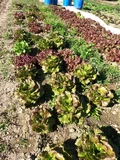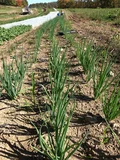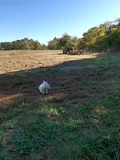TL;DR
We harvested eggplant, scallions, potatoes, and a lot of lettuce. Then we disced in some winter rye.
Lettuce Feed You
There’s a lot of lettuce…growing in the field, around the garage wash area, stored in bins in the walk-in, in my home garden, in bags in my fridge, in my friends’ fridges, on my clothes, in my hair…there’s a lot of it everywhere.
I like lettuce for specific things, sandwiches mostly, and as a minor additive to salads. It just doesn’t taste like much to me and most lettuce in stores or grown locally isn’t the thick and hearty kind that stands up in or as a wrap. But for adding a wet and crunch aspect to things, sure, that makes sense.
And yes, there are many varieties of lettuce, the understatement of the vegetal world. Some are better for salads, some for sandwiches, some for cooking. My palette isn’t unrefined…I’ve traveled the world and will eat just about anything…which is probably why lettuce is not remarkable to me. But people want it, even in the United States and even in much of it is thrown out, so we have it.
For a proper sandwich, I don’t take a leaf or two…I’ll take a handful. Burgers without lettuce are naked, even though there are plenty of other between-two-bun foods that aren’t (like a Cuban pressed sandwich or a grilled cheese). But more than two leaves of whole lettuce is right out. If you want to overload a two-bun sandwich as opposed to a closed-faced or sub sandwich, please thin-slice (definitely not chop) lettuce and serve it immediately.
Come to think of it, there are very few applications for lettuce in cooked or warm scenarios that I think make sense at all. Inside a deep-fried eggroll, cabbage is better, same with wontons I think. Yeah, I think you can keep your warm lettuce to yourself, if I’m around.
Winter Rye for Fields o’ Dry
As we’ve been pulling potatoes out of the upper dry fields this past week, we’ve also been starting to cover crop the lower one. Yesterday, I spread some winter rye and then disced it in before helping with the potatoes. When you’re learning on the tractor, you just have to have all attention payed to what’s happening around you and what’s coming up.
Essentially, winter rye tilled in next May will act as a ‘green manure’, keeping nutrients from leeching out of the growing area and adding to the suppression of other types of weeds in the soil. Since many of these fields get the winter rye, a little carryover seed is never an issue, so we don’t have to worry about 100% termination.
From a soil structure perspective, it’s fibrous tops also contribute OM (organic matter) into the soil, helping to break up the clay-loamy nature of this specific farm’s ground near the marsh. Digging through the chiseled up potato rows, the regular occurrence of huge chunks of clay-heavy dirt almost impossible to break apart are reason enough to be cover cropping these areas heavily.
AI Summary from Field Notes
It’s funny that today’s LLM-driven summarization fixated on “a J-shaped enclosure” topic as if the whole thing would be that. All I meant in my audio notes was to add a little J-shape to the inside of the existing setup to act as a sort of dead end to make the chicken collection at the end of each evening a bit easier. That’s almost verbatim what I said, and yet it went into a thought process about changing the entire yard setup approach.
Well anyway, I’m still working on my RAG re-implementation of the summarization service, so no changes to process have been deployed this week.
Summary
Main Themes
- Daily Farm Operations: Routine tasks like moving chicken coops, cleaning bins, and preparing for harvest.
- Harvesting and Post-Harvest Handling: Processing eggplants, lettuce, and scallions; sorting and storing produce.
- Animal Care: Managing chickens (enclosures, feed), pigs (water access), and sanitation.
- Cover Crop Management: Disking fields for rye seed as part of a cover crop system.
- Infrastructure & Setup: Designing chicken enclosures, sanitation systems, and tools for animal handling.
Activities Performed
- Moved chicken coops and ensured chickens were in their yard.
- Cleaned bins, sanitized the barn, and removed scallion waste.
- Harvested and processed eggplants, lettuce, and scallions (some left in shade/water).
- Assisted with potato harvesting and transported potatoes.
- Set up a chicken yard with a dead-end ladder for easier capture.
- Planned a J-shaped enclosure with feed for chicken management.
- Disked fields for rye seed (cover crop system).
New Things Not Yet Encountered
- Chicken Yard Setup: Using picket fence to create a dead-end ladder for chickens.
- Cover Crop Process: Disking fields for rye seed (specific technique for cover crops).
- Chicken Enclosure Design: Planning a J-shaped area with feed for easier capture.
Questions and Future Research
- How effective is the dead-end ladder for chicken capture?
- Will the J-shaped enclosure work for managing chickens?
- When is the optimal time to disk fields for rye seed?
- How does frequent lettuce harvesting affect plant growth/yield?
- Is shade or water better for scallion storage?
- How can scallion waste cleaning be optimized?
Suggestions
- Implement a J-shaped chicken enclosure with feed for efficient capture.
- Refine chicken yard setup using the dead-end ladder method.
- Monitor rye seed growth after discing to ensure cover crop success.
- Standardize scallion handling (washing, sorting, storage) to reduce waste.
- Document sanitation practices for consistency and efficiency.
Part 1
Main Themes
- Daily Farm Operations: Routine tasks such as moving chicken coops, cleaning bins, and preparing for harvest.
- Harvesting and Post-Harvest Handling: Harvesting eggplants, lettuce, and scallions; washing, sorting, and storing produce.
- Animal Care: Managing chickens (letting them out, creating enclosures), pigs (providing water), and sanitation.
- Cover Crop Management: Disking fields for rye seed as part of a cover crop system.
- Infrastructure and Setup: Creating enclosures for chickens, sanitation systems, and tools for animal handling.
Activities Performed
- Moved chicken coops and ensured chickens were in their yard.
- Cleaned bins, sanitized the barn, and removed scallion waste.
- Harvested and processed eggplants (washed, sorted).
- Harvested lettuce and scallions, with scallions left in the shade or water.
- Helped with potato harvesting and transported potatoes.
- Assisted pigs with water and sanitation.
- Set up a chicken yard with a dead-end ladder for easier capture.
- Planned future improvements for the chicken yard (J-shaped area with feed).
- Disced fields for rye seed as part of a cover crop system.
New Things Not Yet Encountered
- Chicken Yard Setup: Using picket fence to create a dead-end ladder for chickens.
- Cover Crop Process: Disking fields for rye seed (a specific technique for cover crops).
- Chicken Enclosure Design: Planning a J-shaped area with feed for easier capture.
Questions and Future Research
- Effectiveness of Dead-End Ladder: How does the ladder made from picket fence improve chicken capture?
- Chicken Yard Design: Will the J-shaped area with feed work for capturing chickens?
- Cover Crop Timing: When is the optimal time to disk fields for rye seed?
- Harvesting Strategies: How does frequent harvesting of lettuce affect plant growth or yield?
- Scallion Storage: Is leaving scallions in the shade or water better for long-term storage?
- Sanitation Efficiency: How can the process of cleaning scallion waste from the barn be optimized?
Suggestions
- Implement J-Shape Enclosure: Create a J-shaped area in the chicken yard with feed to encourage chickens into a capture zone.
- Refine Chicken Yard Setup: Use the dead-end ladder method for easier manual capture of chickens.
- Monitor Cover Crop Growth: Track the growth of rye seed after discing fields to ensure it meets agricultural goals.
- Standardize Scallion Handling: Develop a protocol for washing, sorting, and storing scallions to reduce waste.
- Document Sanitation Practices: Record steps for cleaning bins and barns to improve efficiency and consistency.
[end of post]
Enjoy Reading This Article?
Here are some more articles you might like to read next:





